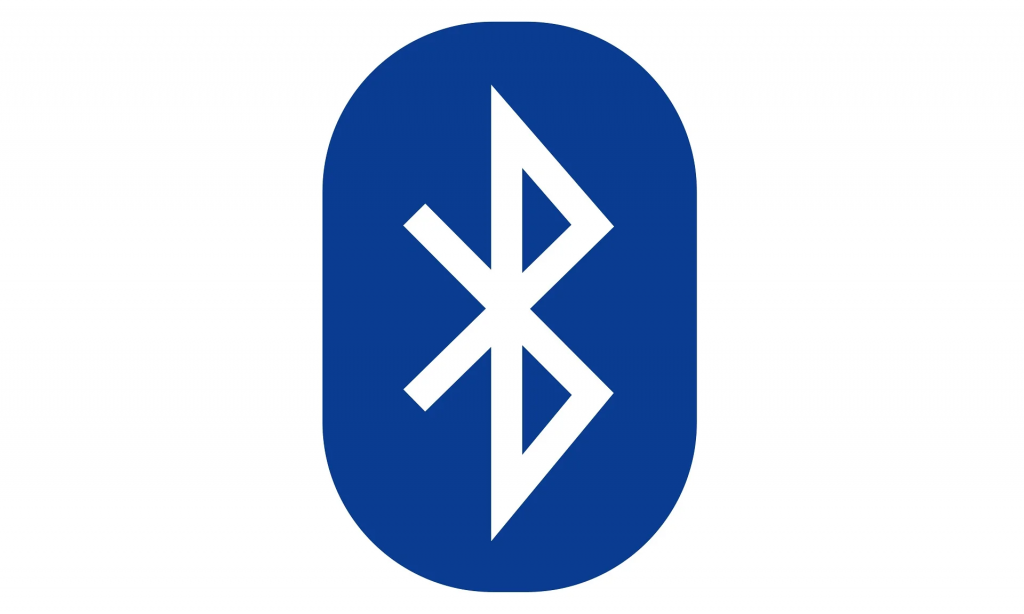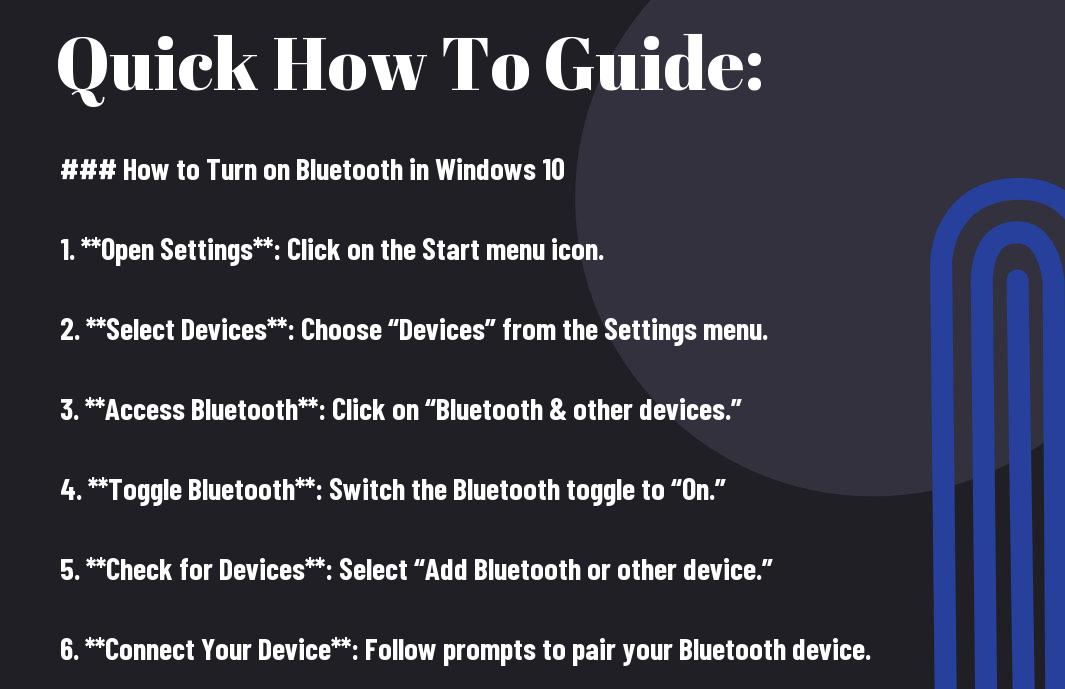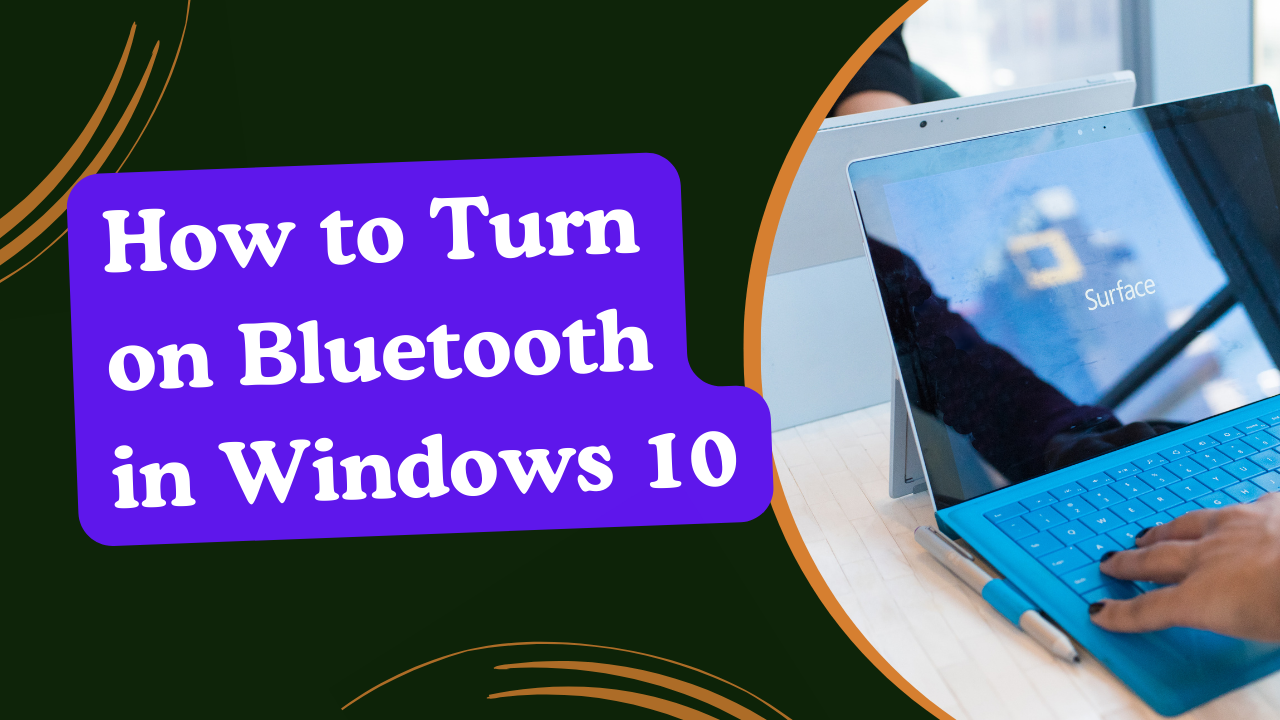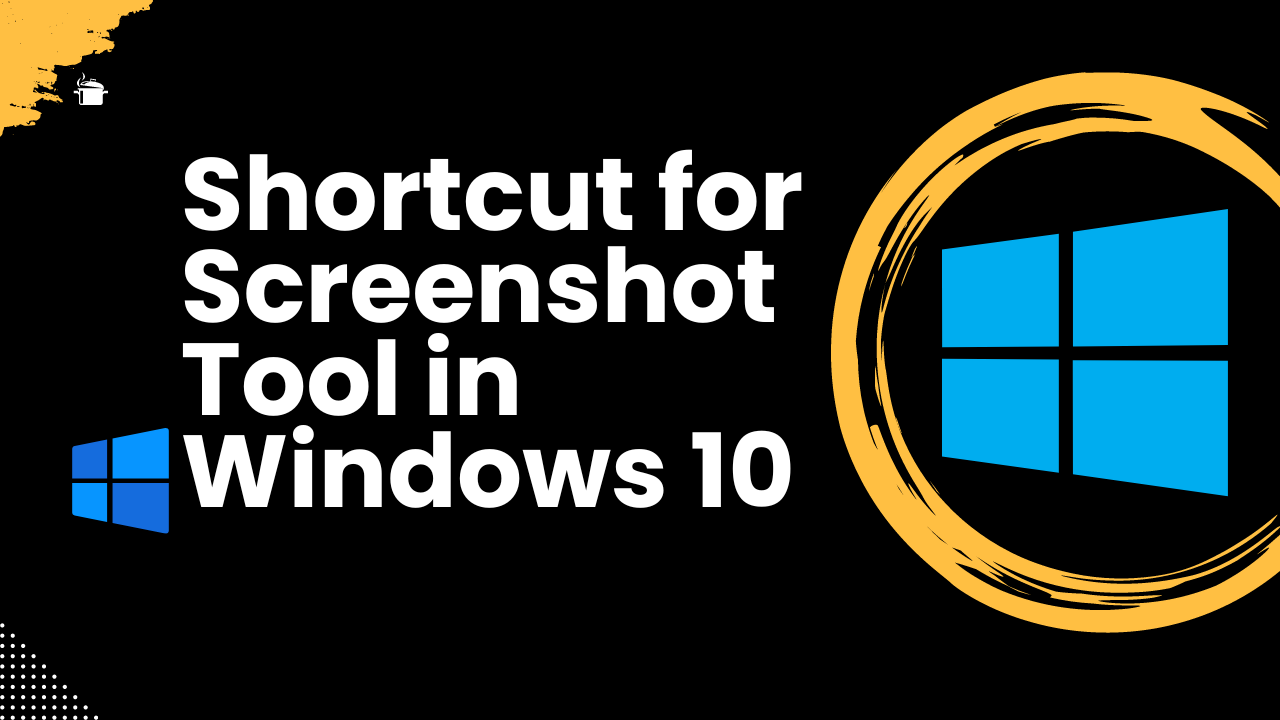Turn on Bluetooth in Windows 10 You want to connect your devices seamlessly, right? Enabling Bluetooth on your Windows 10 device is super important for effortless syncing with headphones, speakers, and much more! In this quick guide, I’ll walk you through the process step by step. Trust me, once you know how to do it, you’ll feel like a tech wizard. So, let’s dive in and get your Bluetooth up and running—your devices will thank you!

Table of Contents
Key Takeaways:
- Accessing Settings: To turn on Bluetooth in Windows 10, navigate to the Settings app by clicking the Start menu and selecting the gear icon.
- Enabling Bluetooth: Within the Settings, go to the Devices section, and select Bluetooth & other devices. Toggle the Bluetooth switch to On to activate it.
- Connecting Devices: Once Bluetooth is enabled, you can add and connect other Bluetooth devices by clicking Add Bluetooth or other device from the same menu, making it easy to link headphones, keyboards, or mice.

Understanding Bluetooth in Windows 10
While many of us use wireless technology daily, it’s important to understand how it works—especially Bluetooth.
What is Bluetooth?
With Bluetooth, you’re dealing with a short-range wireless technology that connects devices like your smartphone, headphones, and even printers without the hassle of cables. It uses radio waves to transmit data, making it super convenient for pairing various gadgets.
Why Use Bluetooth?
Bluetooth, my friends, is a game changer. It eliminates the need for cords, creating a seamless connection between devices. You can connect your phone to your car’s audio system, listen to music on wireless earbuds, or even send files to your friends—all without an ounce of hassle.
This technology is quick, efficient, and incredibly versatile. Imagine the freedom of moving around without being tethered to a device! But remember, if you’re using Bluetooth, make sure your devices are secure to avoid potential privacy risks. It’s a powerful tool, but don’t let your guard down; knowing how to manage your connections is crucial for keeping your data safe. You’ve got this!

How to Turn on Bluetooth in Windows 10
It’s imperative to know how to enable Bluetooth on your Windows 10 device because it allows you to connect with so many awesome gadgets. Whether it’s your phone, headphones, or smart devices, having Bluetooth turned on gets you that wireless freedom you crave!
Using the Action Center
Turn on Bluetooth quickly by clicking on the Action Center, which you can access from the taskbar. Just click the speech bubble icon at the bottom right, and look for the Bluetooth tile. If it’s gray, tap on it to turn it blue, and voila, you’re golden!
Through Settings
If you prefer a more detailed approach, you can enable Bluetooth through Settings. Just head over to the Start menu and click on the Settings gear icon. From there, navigate to Devices, and you’ll see the Bluetooth option ready for activation.
Settings is where you can really dive deep and adjust any Bluetooth preferences to suit your style. Not only can you turn Bluetooth on, but you can also manage your devices and see which ones are currently connected. This is your one-stop shop for all your Bluetooth needs!
Using Device Manager
Assuming you need to access Bluetooth through Device Manager, it’s another viable option. Right-click on the Start Menu and select Device Manager. From there, look for the Bluetooth section, where you can ensure your adapter is functioning properly.
To keep everything running smoothly, make sure your Bluetooth driver is updated. Click on the dropdown for Bluetooth, right-click your device, and select “Update driver.” A strong driver means a more reliable connection, so don’t sleep on this step – it’s crucial for performance!
Tips for Troubleshooting Bluetooth Issues
After submerging into the world of Bluetooth on your Windows 10 machine, you might run into some issues. Don’t sweat it! Here are a few tips I personally use to troubleshoot those pesky Bluetooth problems:
- Restart your device.
- Check if your Bluetooth is enabled.
- Forget and reconnect to the device.
- Run Windows Troubleshooter.
- Check Device Manager for hardware issues.
Recognizing and solving these problems can save you time and ensure your devices work smoothly.
Common Problems and Fixes
There’s a slew of common Bluetooth issues you might face, like your device not being discoverable or failing to connect entirely. A quick fix often involves simply restarting the Bluetooth on your device or reconnecting it from scratch. Sometimes, the solution is just a click away!
Ensuring Drivers are Updated
You have to make sure your drivers are up to date! An outdated driver can lead to all sorts of Bluetooth headaches, from connection failures to downright incompatibility with other devices.
Bluetooth drivers are crucial for your device to communicate effectively with Bluetooth peripherals. Without the latest updates, you might experience challenges like a slow connection or, worse, devices not being recognized at all. Trust me, I’ve been in that frustrating boat. Keeping those drivers updated ensures you’re using the latest features and fixes, bringing your productivity to the next level. So, don’t overlook this step—it’s imperative for a seamless experience!
Factors to Consider for Effective Bluetooth Use
For a seamless Bluetooth experience in Windows 10, there are a few key factors that you need to take into account. Ignoring these could jeopardize your connection and usage. Here are some critical considerations:
- Device compatibility
- Bluetooth range and limitations
- Driver updates
- Interferences
Perceiving these elements will help you make the most of your Bluetooth-enabled devices.
Device Compatibility
Consider that not all devices are created equal in the Bluetooth world. There are specific profiles and standards that your device must support to work together flawlessly. Whether it’s your smartphone, headphones, or any other gadget, checking for compatibility ensures you won’t run into frustrating disconnections or limited functionalities.
Bluetooth Range and Limitations
Consider the fact that Bluetooth has its limitations when it comes to range. Typically, Bluetooth works effectively within a distance of about 30 feet, but various factors can impact this range considerably.
Device placement, obstructions, and even competing wireless signals can hinder your Bluetooth connection. Being aware that Bluetooth is not a long-distance solution is super crucial. I mean, if you’re trying to connect a device from across the room, it may not always work as you expect. Staying within that range will prevent potential connection drops and ensure a seamless experience. Do not forget, your device should be close enough for optimal functionality, so keep it in mind to maintain a smooth operation!
Summing up
To wrap up, turning on Bluetooth in Windows 10 is a breeze, and I want you to own it! Just hit that action center, swipe it to open, and you’ll see the Bluetooth icon ready for you. If it’s not there, look into your settings and look for devices—simple! Note, whether you’re connecting headphones or a new mouse, you’ve got this! Don’t let tech intimidate you; take that leap, and make your devices work for you. Now go out there and connect like a boss!
FAQ
Q: How can I turn on Bluetooth in Windows 10?
A: To turn on Bluetooth in Windows 10, start by clicking on the Start menu (Windows icon) located in the bottom-left corner of your screen. From there, select ‘Settings’ (the gear icon). Next, click on ‘Devices’ and choose ‘Bluetooth & other devices’ from the menu on the left. Toggle the Bluetooth switch to ‘On’ to enable Bluetooth. If you do not see Bluetooth options, ensure that your device supports Bluetooth and that the necessary drivers are installed.
Q: What should I do if Bluetooth is not showing up in Windows 10?
A: If Bluetooth is not appearing in your Windows 10 settings, there are a few steps you can take to troubleshoot the issue. First, check if your device supports Bluetooth. You can do this by going to ‘Device Manager’ (right-click on the Start menu and select ‘Device Manager’), and looking for ‘Bluetooth’. If it’s missing, you may need to install Bluetooth drivers from your device manufacturer’s website. Additionally, ensure that your Bluetooth is enabled in the BIOS/UEFI settings, as some systems allow turning Bluetooth on or off at this level. Finally, updating Windows 10 to the latest version may also resolve the issue.
Q: How can I pair my Bluetooth device with Windows 10 once Bluetooth is turned on?
A: Once Bluetooth is turned on in Windows 10, you can easily pair your Bluetooth device by following these steps. First, ensure that your Bluetooth device is in ‘pairing mode’. Then, go back to the ‘Bluetooth & other devices’ section in Settings (as described earlier). Click on ‘Add Bluetooth or other device’, then select ‘Bluetooth’ from the menu that appears. Your computer will start searching for nearby Bluetooth devices. When you see your device listed, click on it, and follow any prompts that appear to complete the pairing process. Once paired, your device should be ready to use!



